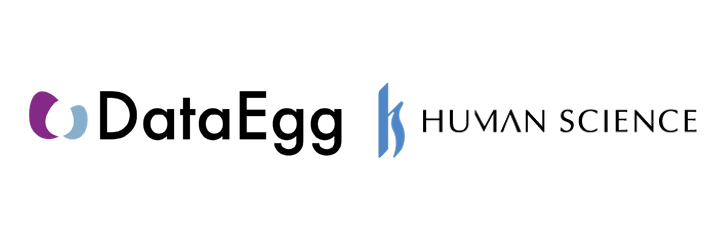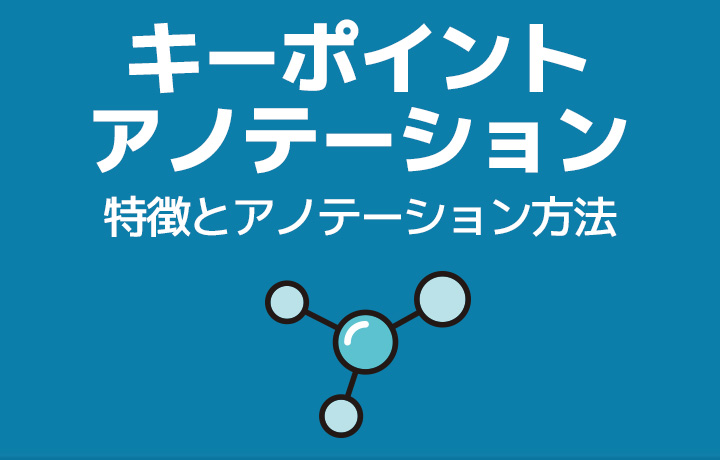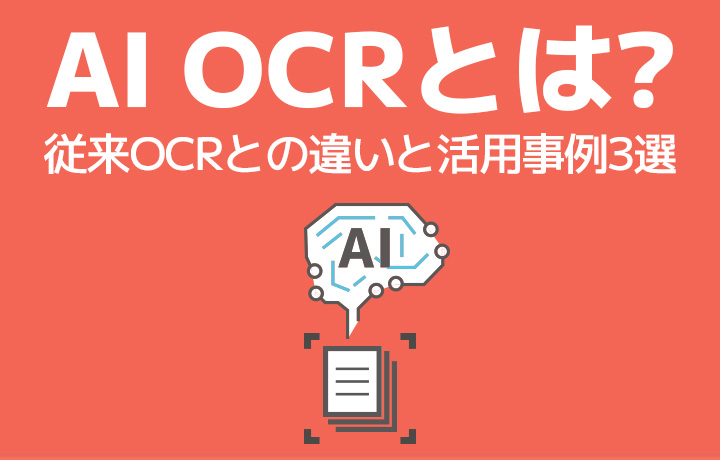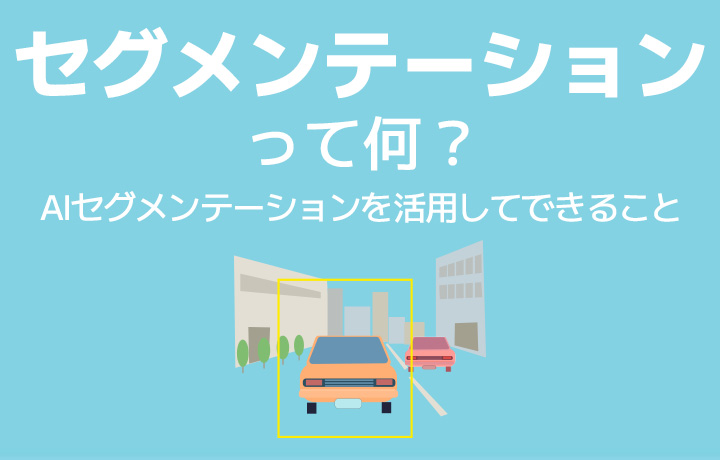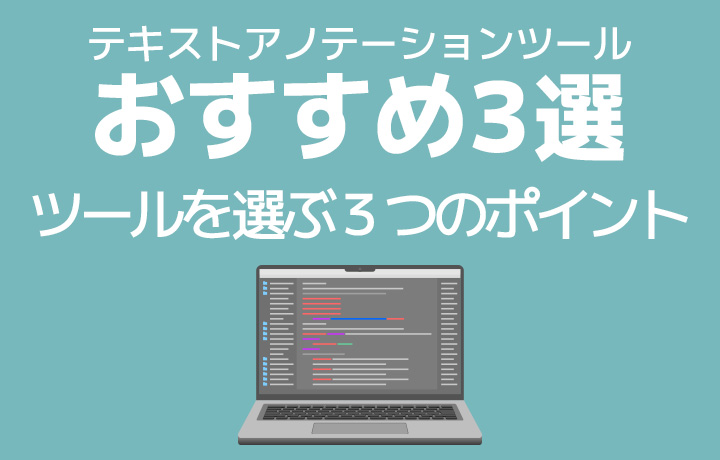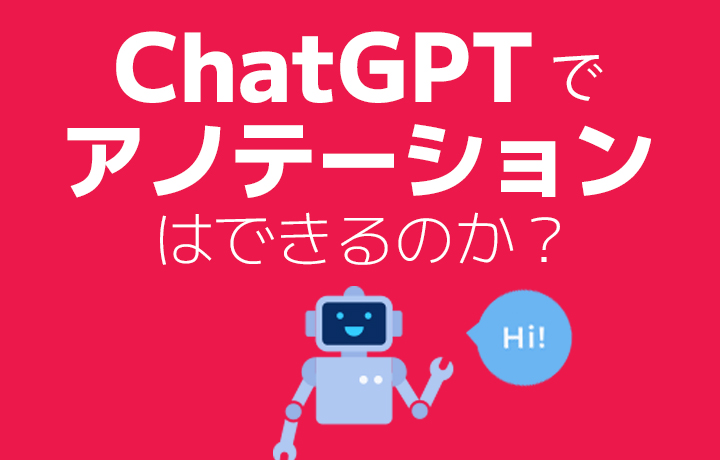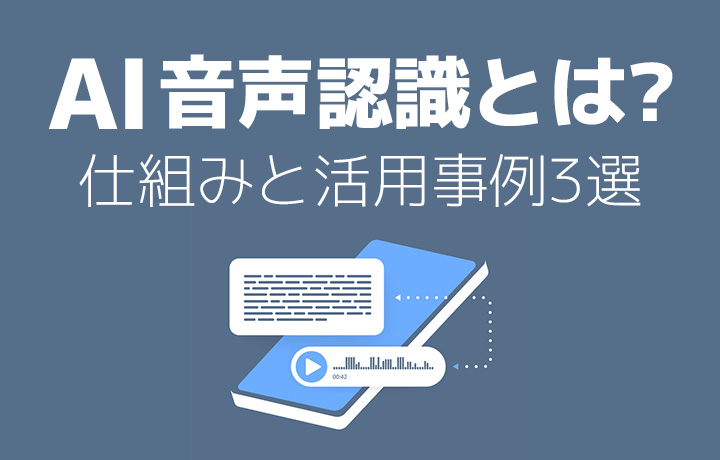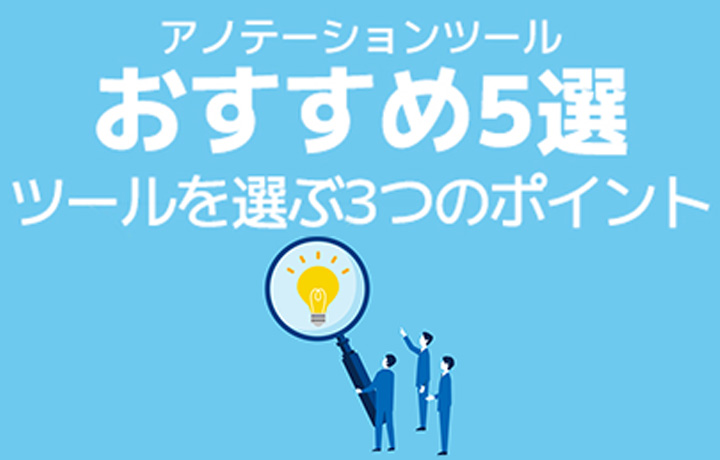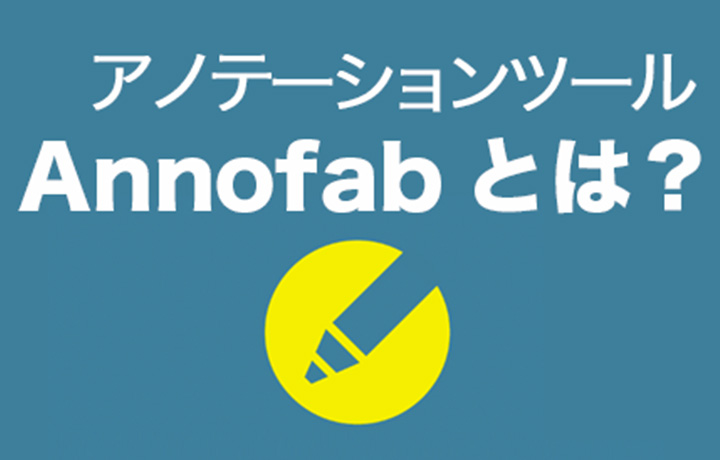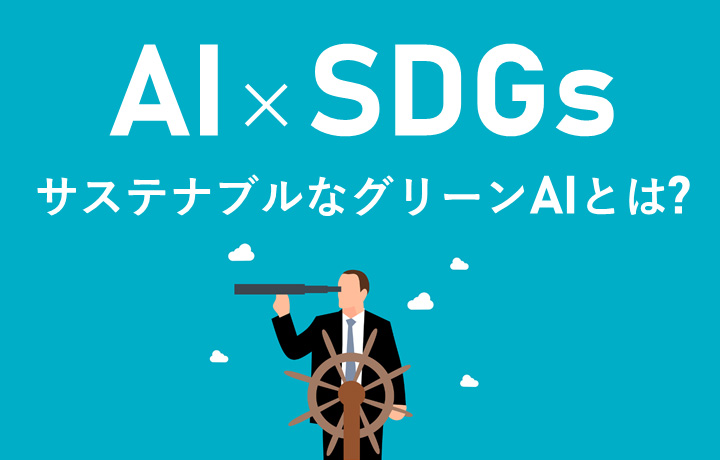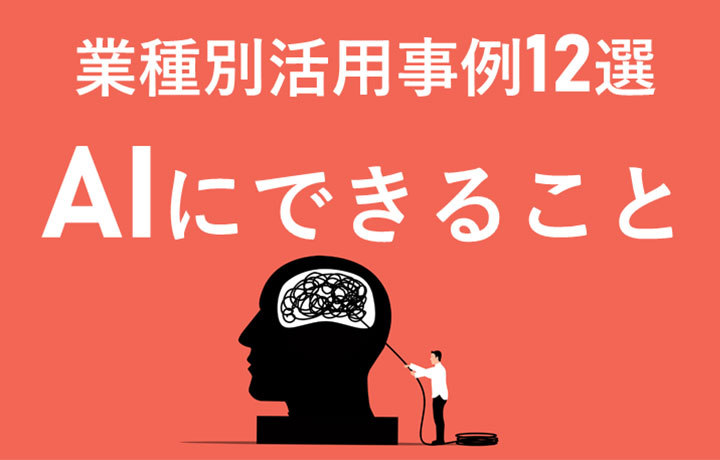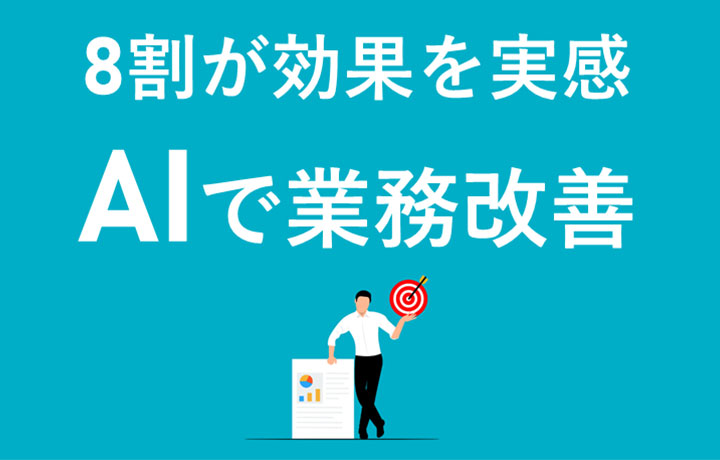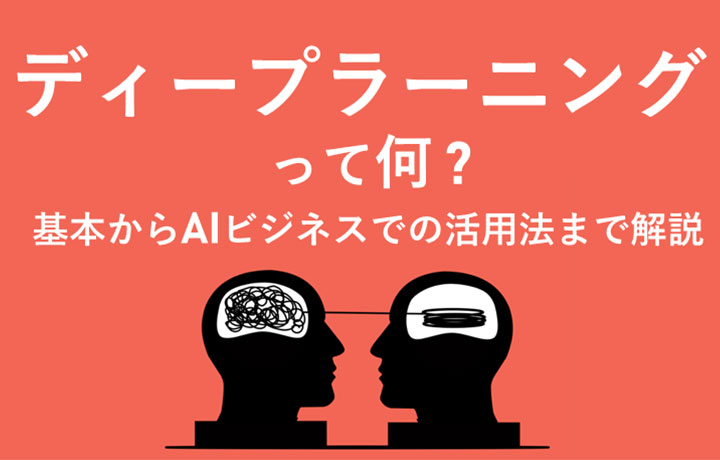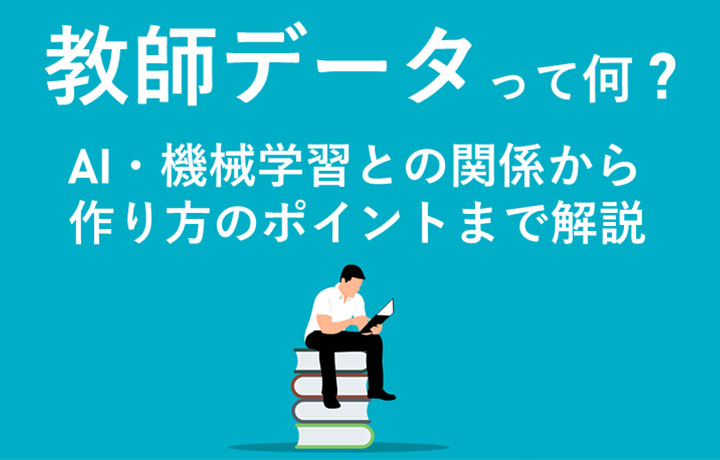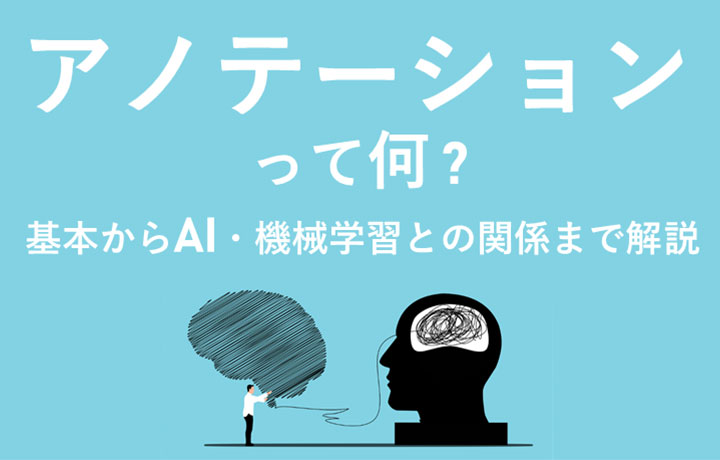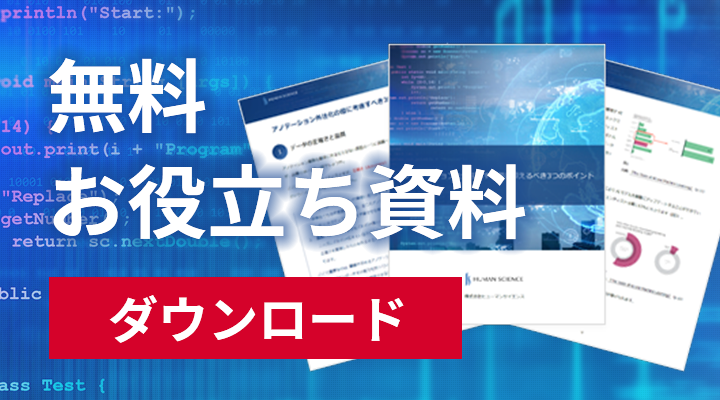
With the increase in AI development, the demand for annotation tools is expected to further increase in the future. Have you heard of the annotation tool that has been developed and improved since 2018 in the annotation tool market? It is the cloud-based all-in-one annotation tool, "Annofab".
We have been using Annofab as a partner company since 2020.
- Table of Contents
-
- 1. What is Annofab?
- 1-1. What is Annofab?
- 2. Benefits of Annofab
- 2-1. Wide range of compatibility and applicability for label and attribute settings
- 2-2. Streamlining Work Efficiency with Flexible Shortcut Settings
- 2-3. Various data that allows you to grasp the overall picture of the project
- 2-4. QA Checker and Smooth Communication for Efficient Completion
- 2-5. Highly Customizable Data Annotation Workflow Settings
- 2-6. Benefits of Cloud-based Tools
- 2-7. Other Benefits
- 3. Cons of Annofab
- 3-1. Disadvantages of Online Tools
- 3-2. In the free plan, you cannot choose a data server.
- 3-3. Output data is only in JSON format
- 3-4. The High Hurdle of Multifunctionality
- 3-5. Impression on UI (Screen Design)
- 4. Examples of Using Annofab
- 4-1. Case Study 1: Autonomous Driving AI Accuracy Improvement Project/AI Technology Development Manufacturer
- 4-2. Case Study 2: Project for Improving OCR Text Recognition Accuracy/AI Technology Development for Manufacturer
- 5. Summary
- 5-1. Summary of Data Annotation Tool Annofab
- 6. For inquiries about utilizing AI, please contact Human Science Co., Ltd.
- 6-1. 48 million records of teacher data creation
- 6-2. Resource Management without Using Crowdsourcing
- 6-3. Equipped with a security room within the company
- 1. What is Annofab?
1. What is Annofab?
1-1. What is Annofab?
Cloud-based all-in-one annotation tool Annofab is a teacher data creation tool developed by Kurasugawa Densan, a venture company based in Nagoya and founded by Nagoya Institute of Technology in 2018.
By registering an account, you can use many features for free on this cloud-based web tool. This means that data annotators can use it immediately on their browser without being greatly affected by their PC specs or environment.
Since its release in 2018, continuous improvements and bug fixes have been made to the tool, making it a more reliable and trustworthy tool.
2. Benefits of Annofab
2-1. Wide range of compatibility and applicability for label and attribute settings
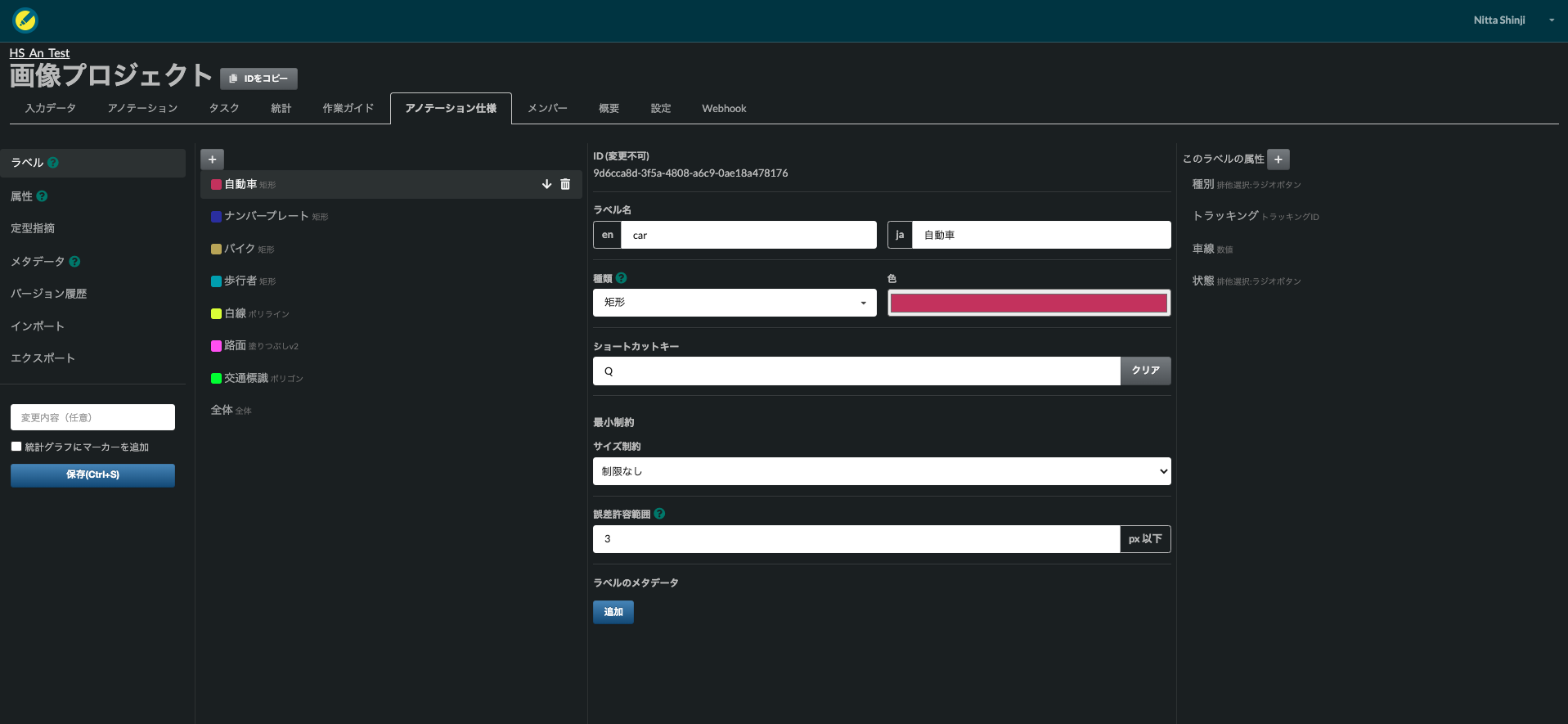
Annofab currently supports data annotation for images and videos.
Image Annotation
- Image classification (classification) for labeling the entire image
- Region extraction that surrounds specific areas in an image (semantic segmentation and instance segmentation)
- Object detection (object detection) that labels rectangles and polygons on specific objects from images
- Continuous lines (polylines) suitable for linear objects such as road vehicle lanes and center lines.
- Annotation (point) indicating position at one point
Video Data Annotation
- Interval annotation on the timeline to capture temporal changes such as movement and blinking
- Classification Data Annotation for Entire Video Data
You can also add various information that can be read from the target object as attributes.
- Tracking ID (assigning an ID to indicate that it is the same object before and after consecutive images)
- Numeric Input
- Radio button
- Dropdown
- Free description (also supports transcription of text)
With such a diverse range of settings, it is possible to handle various data annotation projects.
In addition, these various settings can be centrally managed on the "Data Annotation Specification" screen, and the settings can be output to JSON data, making it easy to reuse in other projects and providing versatility.
In the future, support for spatial axis data annotation for 3D data is planned. This will allow for the detailed tracking of objects and backgrounds captured by LiDAR (such as posture, shape, and condition).
2-2. Streamlining Work Efficiency with Flexible Shortcut Settings
Annofab has the flexibility to customize shortcuts for efficient work. In general tools, there is little freedom as only default settings are available, but with Annofab, you can freely set shortcuts for each project along with class and attribute settings.
As a result, you can focus on data annotation with minimal mouse operations.
In addition to shortcuts, data annotators can freely rearrange the UI elements on the screen, allowing them to create a more user-friendly workspace.
Annofab is a tool that understands the field and is considerate of streamlining the annotation work that cannot be avoided by any means.
2-3. Various data that allows you to grasp the overall picture of the project
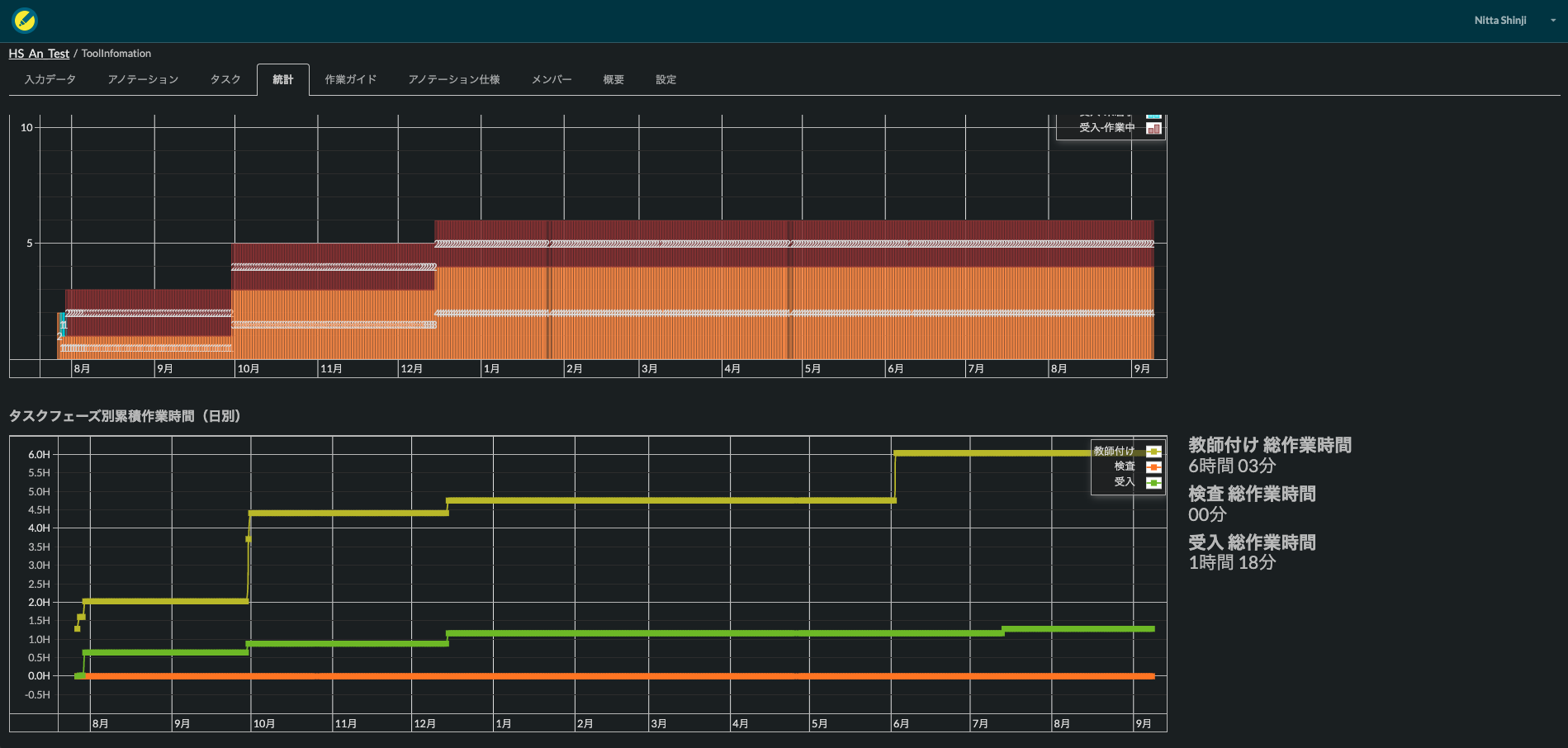
For AI developers and project managers, there is a wealth of statistical data available that allows for a comprehensive understanding of the entire project.
- Overall Project Progress
- Cumulative Working Time per Phase
- Work Time per Member
- Average working time per image
- Number of Inspection Comments
- Number of times tasks have been returned by member
- Number of Data Annotations by Label
- List of annotation data search results by label, etc.
You can also see a list of progress management for "tasks", which are the smallest unit of data annotation work. You can find out who, when, and how far they have progressed, what their current status is, and how much time it took for each phase.
Data annotator can easily check the remaining tasks by displaying only the tasks they have performed with just one button.
By easily understanding this information, it is possible to reduce the time and effort required to manage data annotation projects.
2-4. QA Checker and Smooth Communication for Efficient Completion
In the process of data annotation, the checking and acceptance tasks are very important. Annofab has a feature to point out annotation mistakes and communicate comments. From the display of comments to responses, everything between the data annotator and checker can be smoothly completed within Annofab, taking into consideration clarity and work efficiency.
In addition, for frequently occurring comments, you can use the "standard comment" support function to prevent discrepancies in the issues pointed out by multiple checkers and potential communication problems.
2-5. Highly Customizable Data Annotation Workflow Settings
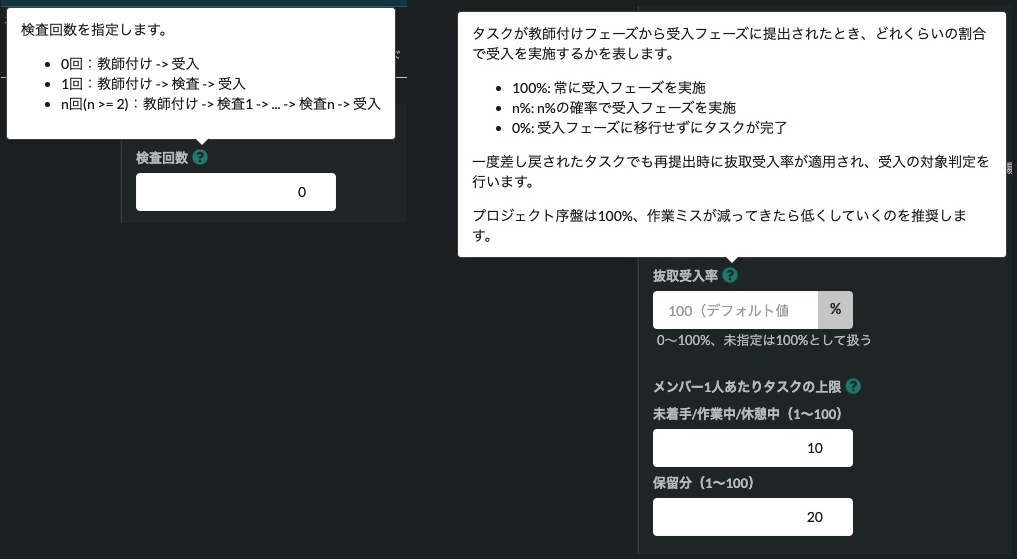
In Annofab's project settings, you can set the number of inspections and inspection rates to any desired value in the phase after the annotation process. This feature allows for the design of an annotation workflow that meets the required quality. Since projects can be created freely, multiple test projects can be created during the trial stage to solidify the most optimal workflow and specifications.
In addition, it is possible to set the inspection rate for each individual annotator as desired, allowing for settings based on the level of annotation proficiency. For example, while the overall project may have a 70% acceptance inspection rate, it is possible to set it to 100% for A-san, who joined the project midway, in order to conduct thorough inspections and feedback, allowing for a design that takes into account training for new employees.
2-6. Benefits of Cloud-based Tools
Annofab is a cloud-based data annotation tool, so the attractive feature is the quick implementation speed that can be used immediately with just user registration. The working data is exchanged with Annofab's server through encrypted HTTPS communication, so there is no need to manage it on a local machine such as a general data annotator's PC.
In addition, for annotation projects and data, it is possible to specify the permissions for each user for each project, allowing for settings that prevent access to data outside of the assigned range for each annotator.
In addition, even during project progress, it is possible to share progress and annotated data with clients without hindering the work of data annotators.
2-7. Other Benefits
The annotation work guide includes many features such as settings for assigning the minimum unit task of work to data annotators (random, selection, task properties), inserting images and tables, formatting, and the ability to publish. It also has many functions such as integration with external systems through Web API, Webhook, and CLI. In addition, the documentation is also extensive, including user manuals that make use of GIF images.
3. Cons of Annofab
3-1. Disadvantages of Online Tools
Annofab is an online annotation tool that operates on the web. Therefore, in tasks such as loading the next image or loading a video task, there may be cases where the speed of the annotator's network environment or PC specs may affect the operation.
In addition, there may be cases where Annofab itself is affected by server or tool system issues. If any issues occur that hinder usage, we will address them through our fault reception form.
>>How should I report when a behavior that seems to be a problem occurs?
3-2. In the free plan, you cannot choose a data server.
Annofab is provided on AWS (Amazon Web Services) managed by the developer, Kasugawa Densan. Therefore, when using the free plan, the annotation data will also be stored on AWS by Annofab. If you need to connect to a cloud server other than AWS (AWS managed by the customer, Azure, Google Cloud Storage, etc.) or your own server, or if you need to handle more confidential data that cannot be taken outside the company, you can use the Business Plan (subject to review) to use the Private Storage and Firewall functions.
What is the difference between the free plan and the business plan?
3-3. Output data is only in JSON format
Unlike some annotation tools that support various file output formats, Annofab only outputs fixed JSON data structures. Therefore, if you need data formats other than JSON, such as CSV, PascalVOC, or YOLO, you will need to prepare a converter or other tool to convert the file format on your own.
3-4. The High Hurdle of Multifunctionality
To use many of the features available in Annofab, there are some necessary tool settings. For example, when generating tasks, it is possible to set the order and number of images as desired, but it is necessary to describe them in a CSV file according to the specified format. In addition, there are many items to set for annotation projects, and it may take some time to get used to the tool due to the difficulty in understanding the necessary project specifications and the procedures and methods for setting them.
For data annotators who actually perform the work, shortcut operations can also be very beneficial, but some workers may put off learning them until they feel the need for work efficiency.
3-5. Impression on UI (Screen Design)
Annofab's UI adopts a dark mode UI. Dark mode UI is said to have features such as "reducing eye strain and increasing concentration", but depending on the displayed area, you may feel that there is a lot of text information and it may be difficult to read.
Also, as the author's personal impression, in terms of the UI color setting specifications, there is a feeling of information overload from the entire tool, and in the display of annotation outlines, the movement seems to be jerky compared to other annotation tools, lacking smoothness in the display.
4. Examples of Using Annofab
4-1. Case Study 1: Autonomous Driving AI Accuracy Improvement Project/AI Technology Development Manufacturer
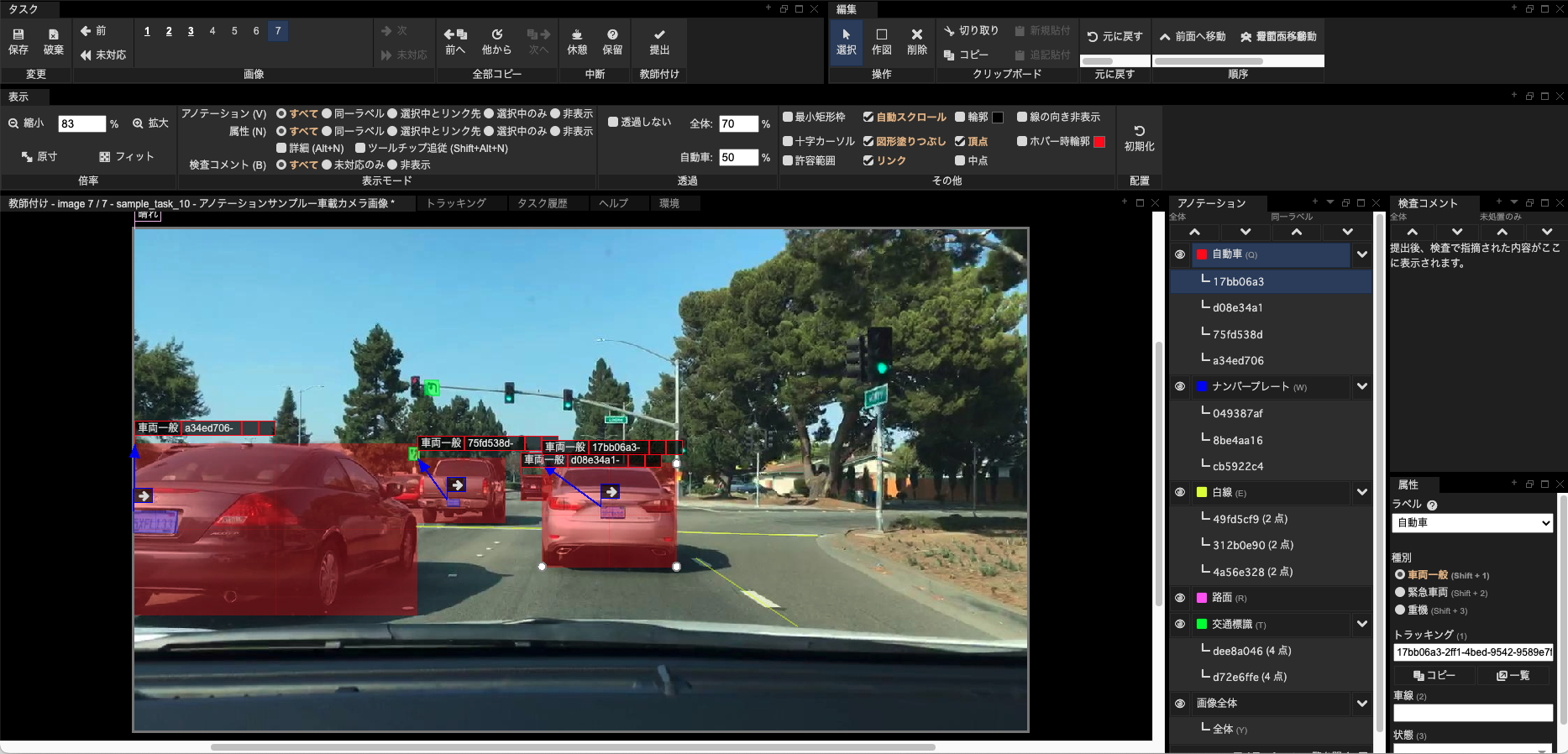
・Work Content
This is an annotation for improving autonomous driving technology, where various objects and areas are tagged by using footage and images from a drive recorder.
・Utilization Points of Annofab
In long-term projects, a key point is how to reduce the workload of data annotators. This is where Annofab's attractive and highly customizable feature, shortcut compatibility, comes into play. Data annotation work can be physically demanding and taxing on one's skills if done for long periods of time. In order to reduce this burden in the field, Annofab was the perfect choice as it allows for efficient operation while performing the tasks.
4-2. Case Study 2: Project for Improving OCR Text Recognition Accuracy/AI Technology Development for Manufacturer
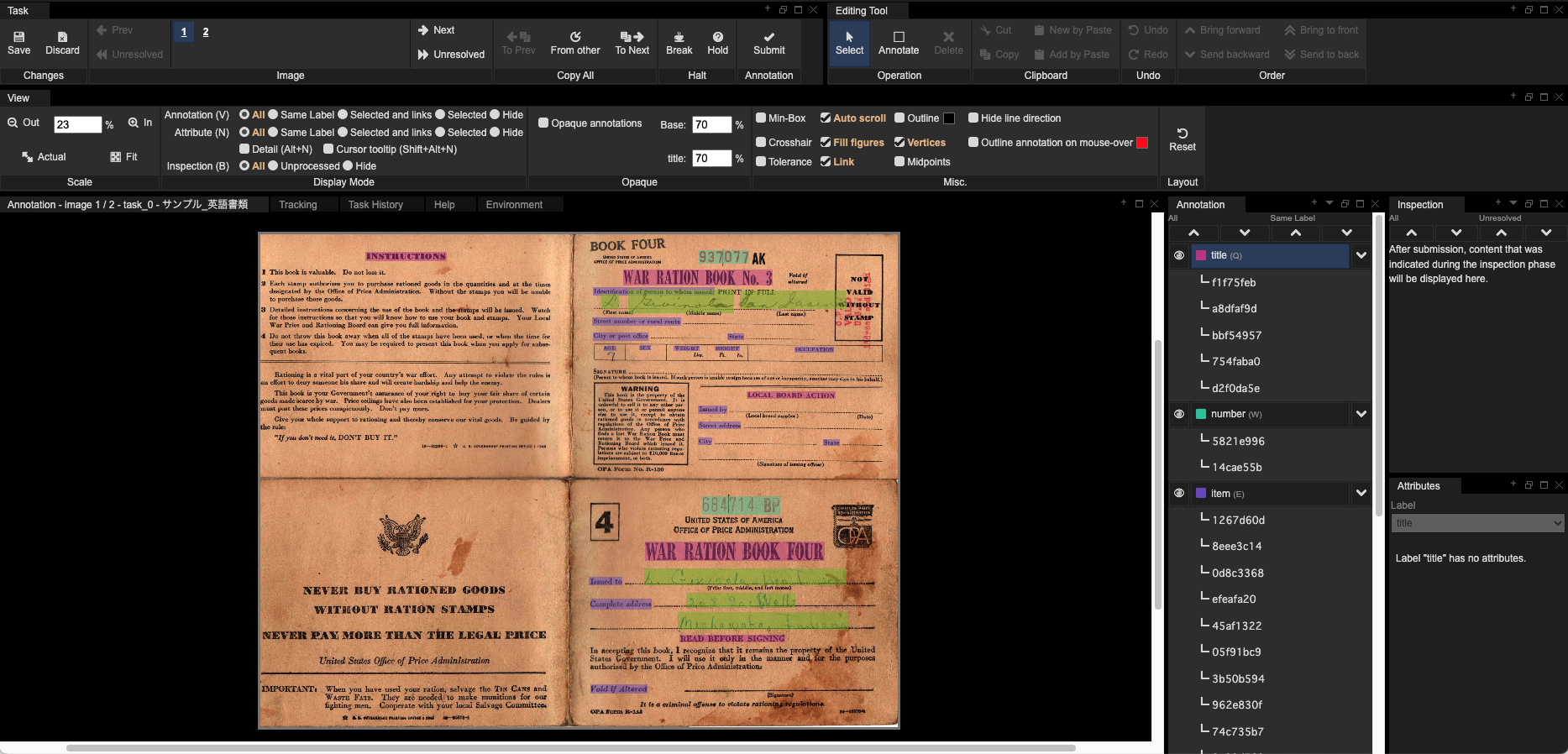
・Work Content
This is the task of extracting specific text areas from English document images and converting them into data that AI can understand in order to improve the accuracy of OCR. Workers are required to manually select specific text areas and add correct information to each one.
・Annofab's Utilization Points
Even when utilizing personnel who do not understand Japanese, Annofab allows for immediate language switching to English through individual settings. With easy annotation operations and the ability to quickly respond to comments from checkers, information can be organized and work can be smoothly progressed while utilizing the tool.
Our website also features numerous case studies from other companies. If you are interested, please refer to this section.
>>AI Annotation Implementation Case Studies | Human Science Co., Ltd.
5. Summary
5-1. Summary of Data Annotation Tool Annofab
Above is an introduction to the annotation tool, Annofab, introduced by Human Science Co., Ltd.
Among cloud-based data annotation tools, Annofab is a highly attractive tool that offers a large number of features for free. It has continuously improved based on feedback from the field. For businesses looking to efficiently manage image and video annotation tools with a limited budget, Annofab is the perfect choice.
6. For inquiries about utilizing AI, please contact Human Science Co., Ltd.
6-1. 48 million records of teacher data creation
"I want to introduce AI, but I don't know where to start."
"I don't know what to ask for when outsourcing."
Please consult Human Science Co., Ltd. in such cases.
At Human Science, we are involved in AI development projects in various industries such as natural language processing, medical support, automotive, IT, manufacturing, and construction. Through direct transactions with many companies including GAFAM, we have provided over 48 million high-quality training data. We can handle various annotation projects regardless of industry, from small-scale projects to large-scale projects with 150 annotators.
>>Data Annotation Service by Human Science Co., Ltd.
6-2. Resource Management without Using Crowdsourcing
At Human Science, we do not use crowdsourcing and instead directly contract with workers to progress projects. We carefully assess each member's practical experience and evaluations from previous projects to form a team that can perform to the best of their abilities.
6-3. Equipped with a security room within the company
At Human Science Co., Ltd., we have a security room that meets the ISMS standards in our Shinjuku office. Even for highly confidential projects, we can provide on-site support. We consider ensuring confidentiality to be extremely important for all of our projects. We continuously provide security education to our staff and pay close attention to handling information and data, even for remote projects.

 For the medical industry
For the medical industry For the automotive industry
For the automotive industry For the IT industry
For the IT industry



